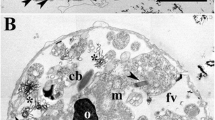Summary
The fine structure of the body wall of the sporocyst and young distomum of Leucochloridium paradoxum was examined with the electron microscope. The integument of the sporocyst which lacks the intestinal tract, is characterised by tall and branched microvilli as well as by perikarya which lie below the basal lamina. The latter are particularly rich in glycogen and lipid inclusions.
The integument of the young distomum is surrounded by a thick layer of fibrous and globular material. The cytoplasm contains elongated secretory granules and crystalloid spines. The perikarya are again situated below the basal lamina.
Zusammenfassung
Die Feinstruktur der Körperwand der Sporozyste und des jungen Distomum von Leucochloridium paradoxum wurde mit dem Elektronenmikroskop untersucht. Das Sporozystenintegument ist durch lange, verzweigte Mikrovilli gekennzeichnet. Die Epidermis-Perikarya, die sehr viel Glykogen und Lipid enthalten, sind versenkt.
Dem Distomumintegument lagert eine Schicht faserigen und globulären Materials auf. Im Zytoplasma finden sich hantelförmige Sekretionsgranula und kristalloide Stacheln. Auch das Integument der jungen Distoma ist versenkt.
Similar content being viewed by others
Literatur
Béguin, F.: Ètude au microscope électronique de la cuticule et de ses structures associées chez quelques cestodes. Essai d'histologie comparée. Z. Zellforsch. 72, 30–46 (1966).
Bils, R. F., Martin, W. E.: Fine structure and development of the trematode integument. Trans. Amer. micr. Soc. 85, 78–88 (1966).
Björkman, N., Thorsell, W.: On the fine structure and resorptive function of the cuticle of the liver fluke, Fasciola hepatica. Exp. Cell Res. 33, 319–329 (1964).
Bråten, T.: The fine structure of the tegument of Diphyllobothrium latum (L.). A comparison of the plerocercoid and adult stages. Z. Parasitenk. 30, 104–112 (1968).
— An electron microscope study of the tegument and associated structures of the procercoid of Diphyllobothrium latum (L.). Z. Parasitenk. 30, 95–103 (1968).
Burton, P. R.: The ultrastructure of the integument of the frog lung-fluke, Haematoloechus medioplexus (Trematoda: Plagiorchiidae). J. Morph. 115, 305–308 (1964).
Erasmus, D. A.: The host-parasite interface of Cyathocotyle bushiensis Khan, 1962 (Trematoda, Strigeoidea). II. Electron microscope studies of the tegument. J. Parasit. 53, 703–714 (1967).
Lee, D. L.: The structure and composition of helminth cuticle. In: Advances in parasitology, vol. IV (B. Dawes, ed.). New York: Academic Press 1966.
Lumsden, R. D.: Cytological studies on the absorptive surfaces of cestodes. I. The fine structure of the strobilar integument. Z. Parasitenk. 27, 355–382 (1966).
Lyons, K. M.: The fine structure of the body wall of Gyrocotyle urna. Z. Parasitenk. 33, 95–109 (1969).
Morris, G. P.: Fine structure of the gut epithelium of Schistosoma mansoni. Experientia (Basel) 24, 480–482 (1968).
Rothman, A. H.: Electron microscopic studies of tapeworms: The surface structures of Hymenolepis diminuta (Rudolphi, 1819). Trans. Amer. micr. Soc. 82, 22–30 (1963).
Senft, A. W., Philpott, D. E., Pelofsky, A. H.: Electron microscope observations of the integument, flame cells and gut of Schistosoma mansoni. J. Parasit. 47, 217–229 (1961).
Storch, V., Welsch, U.: Über den Aufbau resorbierender Epithelien darmloser Endoparasiten. Zool. Anz., Suppl. 1970 (im Druck).
Threadgold, L. T.: The integument and associated structures of Fasciola hepatica. Quart. J. micr. Sci. 104, 505–512 (1963).
Timofeev, V. A.: The cuticle structure of Schistocephalus pungitius at different stages of development in connection with the peculiarities of nutrition of cestodes. Tsitologia, Suppl. 1, 50–60 (1964) [in Russisch].
Wesenberg-Lund, A.: Contributions to the development of the Trematoda digenea. Part 1 (Leucochloridium). The biology of Leucochloridium paradoxum. Danske Selsk. Skr. Nat. 9, 1–221 (1931).
Author information
Authors and Affiliations
Additional information
Die Untersuchungen wurden mit Unterstützung durch die Deutsche Forschungsgemeinschaft durchgeführt.
Rights and permissions
About this article
Cite this article
Storch, V., Welsch, U. Der Bau der Körperwand von Leucochloridium paradoxum . Z. F. Parasitenkunde 35, 67–75 (1970). https://doi.org/10.1007/BF00259531
Received:
Issue Date:
DOI: https://doi.org/10.1007/BF00259531




